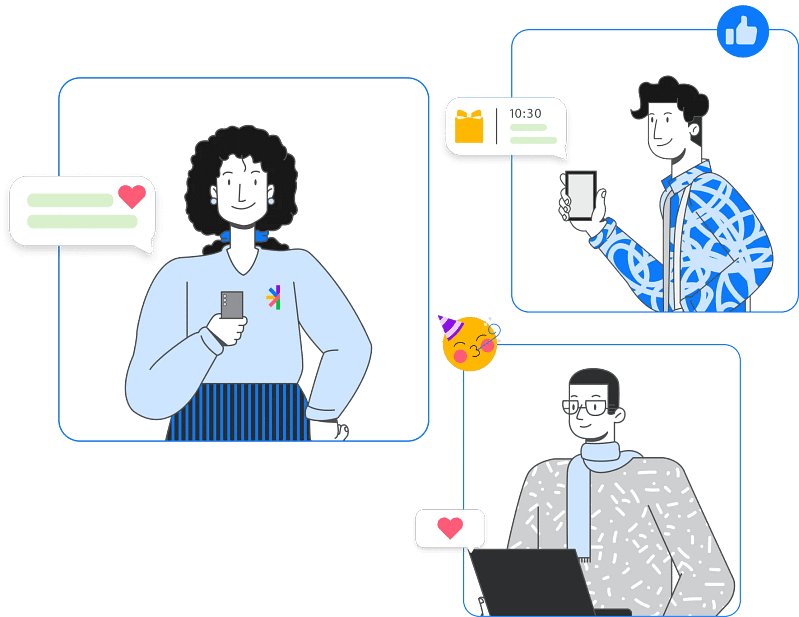STADIUM FOR EMPLOYEE ENGAGEMENT
Employee Engagement
Employee engagement plays a key role in benefiting the organization. The organization's future and the caliber of the workplace are determined by its human capital, commonly referred to as its workforce.
Create custom employee engagement campaigns.

Employee Engagement - Definition and Meaning
Employee engagement is defined as the degree to which employees are mentally and emotionally connected to their employer, their coworkers and to their jobs and the firm's goals. Engaged employees are more committed and productive and contribute favorably to the corporate culture. They're not simply working for a salary or the next promotion; they're engaged in their work and eager to contribute to the organization's success.

STREAMLINE EMPLOYEE ENGAGEMENT PROGRAMS
Employee Engagement Ideas
Employee engagement is crucial for fostering a positive work environment and increasing productivity. Here are some ideas to boost employee engagement:
Open Communication Channels: Establish open-door policies, regular team meetings, and anonymous suggestion boxes to encourage communication between employees and management.
Recognition and Rewards: Implement an employee recognition program to acknowledge employees for their hard work and achievements. This can include employee of the month awards, shout-outs in team meetings, or small rewards like gift cards or extra time off.
Professional Development Opportunities: Invest in employee growth by offering training programs, workshops, and opportunities for advancement. Encourage employees to set and achieve career goals within the company.
Flexible Work Arrangements: Allow flexibility in work schedules or remote work options when feasible. This shows trust in employees and helps them achieve better work-life balance.
Team Building Activities: Organize regular team-building events and activities to strengthen relationships among coworkers. This can include team lunches, outdoor activities, or volunteer opportunities.
Wellness Programs: Promote employee well-being by offering wellness programs such as gym memberships, yoga classes, or mental health resources. Healthy employees are more engaged and productive.
Feedback Mechanisms: Create a culture of feedback by regularly soliciting input from employees on company policies, procedures, and work environment. Act on feedback to show employees their opinions are valued.
Social Events: Organize social events outside of work to help employees bond and connect on a personal level. This can include holiday parties, company outings, or themed events.
Clear Goals and Expectations: Ensure that employees understand their roles, responsibilities, and expectations. Set clear goals and provide regular feedback on performance to keep employees motivated and engaged.
Employee Empowerment: Empower employees by giving them autonomy and ownership over their work. Allow them to take on new projects, make decisions, and contribute ideas to improve processes.
Celebrate Milestones: Recognize significant milestones such as work anniversaries, project completions, or personal achievements. This shows appreciation for employees’ dedication and commitment to the company.
Create a Positive Work Environment: Foster a positive work culture by promoting inclusivity, diversity, and respect among employees. Encourage teamwork, collaboration, and mutual support.
The value of Stadium
Employee Engagement Strategies
Excellent ways to motivate employees
Adopt a Bottom-Up Approach
Empower employees to participate in decision-making processes and share their insights, fostering a sense of ownership and engagement in organizational goals. This approach enhances workforce engagement and drives employee morale.


Promote Two-Way Communication
Encourage open communication channels where employees can voice their opinions, concerns, and ideas, fostering trust and engagement. Utilize employee engagement survey questions to gather feedback and address engagement issues effectively.
Encourage Community Participation
Involving employees in community activities and corporate social responsibility initiatives fosters a sense of belonging, enhances engagement, and strengthens the organization's social impact.


Recognize Good Work
Implement recognition programs to acknowledge and appreciate employees' contributions, boosting morale and engagement. Recognizing achievements positively impacts employee performance and enhances engagement levels.
Invest in Personal Growth
Support employees' professional development and growth opportunities, demonstrating a commitment to their success and fostering higher engagement levels. Providing learning and development opportunities enhances employee engagement and satisfaction.


Hire Competent Managers
Ensure managers are equipped with the skills to lead and engage their teams effectively. Competent leadership is crucial for driving employee engagement and performance.
Create a Sense of Purpose
Align employees with the organization's mission and values to instill a sense of purpose and meaning in their work, driving higher engagement levels and commitment to organizational goals.


Celebrate employee work anniversaries
Use rewards and recognition programs to celebrate anniversary milestones. Celebrate with touching words from the fellowship among staff and managers on their work anniversary. Employee recognition is usually awarded by giving perks like a special lunch or savoring a gift for such occasions.
Sketch a Success Roadmap
Provide clarity on career advancement opportunities and goals, outlining a clear path for employees' success within the organization. This roadmap enhances employee engagement by setting clear expectations and fostering growth.

MANAGING EMPLOYEE ENGAGEMENT CAMPAIGNS
Employee Engagement Best Practices
Communicate Employee Engagement Strategy
The employee engagement strategy’s success is determined by how effectively everyone first understands it. The following are the important points that must be addressed:
- What is the strategy, and what does it accomplish for the organization?
- How will it be performed (by surveys, current data, etc.)?
- What metrics will be used (customer involvement, productivity, etc.)?
- Details of the survey and subsequent revisions.
- How will the organization enhance its metrics?
The more specific, the better—always.
Identify Action Areas
Without particular areas to assess and improve, a firm could not implement a successful employee engagement plan. Rather than attempting to address every factor influencing employee engagement, firms must respond to these two inquiries:
- What are the most important factors influencing employee engagement?
- Which among them can be tackled with available resources?
Proper resource planning with specific action items creates or ruins a strong strategy.
Identify SMART Goals
This is a no-brainer. An organization lacks direction in the absence of goals.
- What does it hope to achieve? What needs to be improved?
- What purpose does the approach serve?
All of these questions must be answered first.
Furthermore, such goals must be specific, quantifiable, attainable, realistic, and timely (S.M.A.R.T.). By keeping tangible outcomes in mind, managers will be able to correctly execute the plan and determine whether or not it is producing the intended results.
Prepare Action Plan
Once specific goals have been established, an action plan for achieving them must be developed. At this stage, resources are allocated, and key performance indicators (KPIs) are defined to allow for progress assessment.
It is critical to understand that the efficacy of the action plan is dependent on the direct supervisors. When results are distributed, and new attempts are proposed, it increases employee engagement.
Ensure Sustainable Development
A good employee engagement plan also considers effectively sustaining engagement initiatives over time. Numerous studies and industry best practices recommend organizations:
- Adhere to an extended plan that surpasses a single survey.
- Get workers and leadership involved and find a middle ground to improve collaboration.
- Measure and optimize until you achieve the required figures.
- Align with corporate goals to improve consistency.
To be honest, developing a successful employee engagement plan takes more than a single day. Only a continuous process may produce remarkable outcomes.

Importance and Benefits of Employee Engagement
Stadium
Global employee engagement platform trusted by top companies
170+
Countries within our fulfillment network
99.9%
Recipient satisfaction with Stadium gifts & experiences
14m+
Gifts fulfilled globally to date
Employee Kudos
Create a employee engagement campaign with kudos recogniton.
Swag and Snacks
Keep your team engaged with swag and snacks gifting. Create company gift store to ceelbrate every appreciation and rewards
Team Events
Host in person or virtual comapny wide events to boost engagement.
AWARDED TOP 100 FASTEST GROWING PRODUCTS (2023) BY G2


